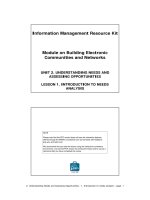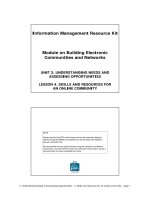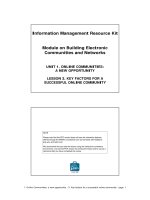UNIT 2. UNDERSTANDING NEEDS AND ASSESSING OPPORTUNITIES LESSON 3. ASSESSING THE USER’S NEEDS doc
Bạn đang xem bản rút gọn của tài liệu. Xem và tải ngay bản đầy đủ của tài liệu tại đây (646.83 KB, 15 trang )
2. Understanding Needs and Assessing Opportunities - 3. Assessing the user’s needs – page 1
Information Management Resource Kit
Module on Building Electronic
Communities and Networks
UNIT 2. UNDERSTANDING NEEDS AND
ASSESSING OPPORTUNITIES
LESSON 3. ASSESSING THE USER’S NEEDS
© FAO, 2006
NOTE
Please note that this PDF version does not have the interactive features
offered through the IMARK courseware such as exercises with feedback,
pop-ups, animations etc.
We recommend that you take the lesson using the interactive courseware
environment, and use the PDF version for printing the lesson and to use as a
reference after you have completed the course.
2. Understanding Needs and Assessing Opportunities - 3. Assessing the user’s needs – page 2
At the end of this lesson, you will be
able to:
• identify the importance of the needs
assessment for an online community
building project;
• recognize the types of information to
be collected during the assessment;
• illustrate the methods for collecting
information; and
• recognize people’s hesitancy or
resistance.
Objectives
Introduction
In this lesson we will discuss the second activity of a needs analysis: the
needs assessment.
Needs assessment: assessing the needs of the potential
online community members
Capacity building assessment
Analysing technical, financial, institutional and social
barriers
Defining your idea: building up your team and identifying goals
2. Understanding Needs and Assessing Opportunities - 3. Assessing the user’s needs – page 3
It results in clear answers to
well developed and
relevant questions.
The information you collect for
your needs analysis will help
define the functional
requirements, outreach
strategy, training and other
elements for your online
community that are developed
later in the process.
What a needs assessment is
A needs assessment is a learning effort that consists of research and
analysis of data collected from potential users to develop steps for
implementing the online community.
Many people assume that those most likely to be part of the online
community will automatically want to participate - that “if you build it, they
will come.”
Unfortunately, this is not always true.
For example, an online
community project for a
community radio should be
focused on the needs of its
members: the radio
broadcasters.
It is critical to the success of your online community project to identify
the needs of those who will be served by and participate in the
community.
Online activities need to focus around their needs.
Why needs assessment is important
2. Understanding Needs and Assessing Opportunities - 3. Assessing the user’s needs – page 4
Women don’t use the online
community at all.
For example, let’s consider the following problems emerging during the
implementation of an online community building project. What questions have
been forgotten?
People can’t use the chat function,
as they are never connected to
the PC at the same time.
People don’t use the function for
creating and publishing online
content.
Will members generate knowledge
that needs to be captured,
processed, and distributed?
What are the gender issues that
might influence use or rejection of
your online community?
Do members need synchronous
(same time) and/or asynchronous
(different time) interactions?
Click on each option and drag it in the corresponding box.
When you have finished, click on the Confirm button.
a
1
Why needs assessment is important
Information about potential community members
• What type of area they live in (rural,
urban, etc.) (see next slide)
• What region of a geographic area they are
from
• Gender
• Age
• Main source of livelihood
• Health status
• Literacy level
• Education level
• Personal interests
• Professional interests
Which kind of information do you need to collect in your assessment?
First, you should identify who your potential online community members
will be. You need to collect information about their general
characteristics:
It is also useful to understand how people view the host organization’s role
in the project: Is there a strong degree of trust?
2. Understanding Needs and Assessing Opportunities - 3. Assessing the user’s needs – page 5
Questions related to remote rural areas
Following are other questions to consider particularly related to remote rural
areas:
• What core communications services do local residents need and are willing to
pay a modest fee for if a shared technology resource (e.g. telekiosk, shared
computer) is place in their village?
• What other services can a shared community technology resource provide
that meets a community need and motivates local people?
• What is the best way to describe the core communication services provided by
the shared resource to local people to gain acceptance?
• What is the best location for a shared resource to ensure project acceptance
and ensure gender equity?
Information about potential community members
At the heart of an online community project is person-to-person
communication and sharing. That is why you need to assess the
communication context.
This means collecting and analyzing information on the following areas:
Information about the communication context
Having a firm understanding of these issues is critical later on in your
design/implementation process when you are selecting the right technology
tools and strategies for your community.
Let’s look at what information is relevant to the assessment in each of these
areas.
• Access to ICT
• Culture
• Language
• Sociability
• Gender
2. Understanding Needs and Assessing Opportunities - 3. Assessing the user’s needs – page 6
• Access to ICT
• Culture
• Language
• Sociability
• Gender
Real access is more than just physical
access.
Computers and connections are
insufficient if the technology is not used
effectively because it is too expensive,
misunderstood, discouraged from being
used or not sustainable. Other then the
physical access, you need to check:
• if the technology is appropriate and
affordable for people to use,
• if people understand how to use it,
• if they are limited in their use of
technology by socio-cultural factors,
• how people feel about technology,
• if the economic/political environment
can sustain technology use and
integration.
Real Access – QUESTIONS LIST
Information about the communication context
In many cultures, information retrieval
and presentation (the recording of
wisdom and history) is still done
through speech, drama, painting, song,
or dance.
The use of writing and the invention of
the printing press made mass
communication easier. More recent
technological innovations further
increase the reach and speed of
communication, culminating, for now,
with digital technology.
Understanding what the influence is of
these innovations, particularly the
Internet, is critical to consider as you
determine what the needs are of those
who might join and participate in the
online community.
• Access to ICT
• Culture
• Language
• Sociability
• Gender
Culture – QUESTIONS LIST
Culture – A REAL EXAMPLE
Information about the communication context
2. Understanding Needs and Assessing Opportunities - 3. Assessing the user’s needs – page 7
At this stage of assessment your
aim is to determine what language
challenges exist that will affect the
building and maintenance of the
online community.
Online communities need to have
messages and information that
provide opportunities for local
people to interact and
communicate with each other,
expressing their own ideas,
knowledge and cultures in their
own languages.
Knowing about language issues will
influence your design and
functional considerations.
• Access to ICT
• Culture
• Language
• Sociability
• Gender
Language – QUESTIONS LIST
Language – A REAL EXAMPLE
Information about the communication context
Women constitute half of the
world’s population, yet their
access to ICTs remains
marginal.
It is important to address the
root cause rather than the
symptom, which is the low level
of access of women to ICTs.
The solution does not lie in
simply providing women with
computers, but to try and
identify the factors determining
women’s marginal use and
control over ICTs.
• Access to ICT
• Culture
• Language
• Sociability
• Gender
Gender – QUESTIONS LISTGender – A REAL EXAMPLE
Information about the communication context
2. Understanding Needs and Assessing Opportunities - 3. Assessing the user’s needs – page 8
• Access to ICT
• Culture
• Language
• Sociability
• Gender
Sociability – A REAL EXAMPLE
Sociability is how a community’s
purpose, its members and governing
structure influence the group and
person-to-person online interaction.
Questions relating to sociability need
to be explored with stakeholders
during the needs analysis to identify
the opportunities and barriers to social
interaction.
Specifically, you will need to fully
understand what will motivate the
targeted population to participate in
the project, how they could be
segmented (by geography,
development area, or other interest
area), which individuals could play the
role of online helpers, thought leaders
or moderators.
Sociability – QUESTIONS LIST
Information about the communication context
Now you can start to think about a strategy for finding
the answers, in order to apply the results to refine your
goals.
In your opinion, which of the following questions must
be asked directly to potential online community
members?
What type of area do people live in?
What is their literacy level?
What is the percentage of women?
How do people interact with one another?
Do they have confidence in and understand the
implications of the technology?
Click on the answers (two or more) of your choice
How to collect information
2. Understanding Needs and Assessing Opportunities - 3. Assessing the user’s needs – page 9
Collecting information from potential
members of an online community can be
challenging.
First, it is often difficult to get people to
share their desires with you.
Beyond that, when they do share, the
information they give you may not be
totally accurate. Always be aware of this
as you analyse the information you
collected. Discuss as a team if the
information seems accurate or not.
If you sense it isn’t, make sure you have
collected information through a variety of
methods. Then look for trends.
How can I be sure that
information will be collected
in a systematic way?
How to collect information
For example, you can consider
what information you have from
people who work in
organizations, and what bias they
bring that may affect the way they
responded to questions.
Maybe there is a sub-group of
people who are less versed in use
of the Internet and this had a
major impact on the way they
responded when surveyed. Be
aware of the diversity of the people
who responded.
How to collect information
It is also helpful to segment the information you have collected by the
type of people whom you collected the information from.
2. Understanding Needs and Assessing Opportunities - 3. Assessing the user’s needs – page 10
Focus group discussions take place with a small group of
selected people to collect information about an issue.
The following are some research methods you can apply to obtain information from people.
How to collect information
Some tips for conducting focus groups
• Prepare carefully. Careful planning in advance will help you get the most relevant output.
• Clearly identify your objective(s) for the focus group. What do you want to know?
• Develop questions that match the objective(s). More than one person’s perspective is usually helpful in
developing the best questions.
• Develop an agenda to guide the flow of the session. Set a timeline for the flow of the session.
• Select a facilitator who will be able to collect useful information from the group and keep the session
on track.
• Invite people with relevant information to give and who will actively participate to be part of the focus
group. Make sure they know how much of their time you will need.
• Select a good location that is comfortable with minimal distraction.
• Record the session if at all possible. If it’s not, have someone there who can focus on the job of note
taking.
• Take time immediately after the focus group concludes to jot down any additional notes and
observations and to verify that any recording that was done worked properly.
• Conduct your analysis as soon as possible after the focus group concludes so that your own
impressions from the session are still fresh.
Questionnaires and surveys are a structured way to gather
quantitative information either on paper, by phone, or online.
How to collect information
Some tips for conducting surveys
• Prepare carefully. Careful planning in advance will help you get the most relevant output.
• Clearly identify your objective(s) for the survey. What do you want to know?
• Develop questions that match the objective(s). More than one person’s perspective is usually helpful in
developing the best questions.
• Think about what you will do with the data. If you can, do some practice analysis on some answers
you make up for your survey. This will help you to be sure you have the expertise available to you to get
the information you need. It may also help you in refining your questions.
• Decide who you will ask to take your survey. This will help you decide the best way for you to collect
responses to the survey.
• Keep the questions and the design of the survey as simple as possible. If possible, have at least one
other person respond to the survey for practice. This will help you to identify anything that might be
confusing about your survey.
• If possible, provide an incentive for those who respond to increase the number of responses.
2. Understanding Needs and Assessing Opportunities - 3. Assessing the user’s needs – page 11
Semi-structured interviewing are guided conversations where
broad questions are asked and new questions are allowed to arise as
result of discussion. This method is particularly helpful when you
want to gain knowledge from someone who has a unique insight.
How to collect information
Some tips for conducting interviews
• Prepare carefully. Careful planning in advance will help you get the most relevant
output.
• Clearly identify your objective(s) for the interview. What do you want to know?
• Develop questions that match the objective(s). More than one person’s perspective is
usually helpful in developing the best questions. In this type of interview, usually open
questions are used the most “What do you think about xyz?”
• Develop a guide for the interview that lays out the questions in a logical order so you
can use it to record answers/notes and can easily consult it during the interview.
• Record the interview if at all possible.
• Use follow up questions to get complete answers i.e. “Can you elaborate on what you
said about xyz?”
An online community can improve how
people interact with one another, share
knowledge, raise money, and achieve
programme goals. Users can reduce
isolation to increase independence. Despite
this and many other benefits, ICT often
alienates people, increases stress and
leaves some people feeling incompetent.
Change means having to acquire new
knowledge and skills.
It is important to explore general
attitudes and feelings about technology
as well as those about change. Negative
feelings can lead to total rejection of a plan
for an online community from within your
organizations and the targeted population.
Dealing with people’s resistance
Since I have started
interviews, I have the
impression that some
people are not so happy
to collaborate…
2. Understanding Needs and Assessing Opportunities - 3. Assessing the user’s needs – page 12
People can have different technology attitudes.
According to research on technology stress, people’s general reactions to technology
characteristically fall into three “Techno-Types”:
Dealing with people’s resistance
Those who are eager
to use technology.
Those who are
hesitant.
Those who are
resistant.
They are technophiles, and the
first to embrace new technology
tools. They view technology as
fun and challenging. They
expect to have problems with
technology, so when there is a
glitch, instead of blaming
themselves, they have fun
solving the problem.
They prefer to wait until a new
technology is proven before they
try it. Even then, they may resist
until they are convinced it is
absolutely totally necessary. This
group expects problems, but
doesn’t enjoy solving problems
or think a solution is readily
available.
Technology is not fun for
resisters. They may feel that
they will break the computer
if they touch it. They feel
intimidated and stupid. They
simply can’t deal with any
problems that may come up
and each one that does
validates their view that
technology is useless.
For example, how would you classify the attitude of the following radio
broadcaster towards the use of Internet in the community?
Eager
Hesitant
Resistant
Click on the answer of your choice
I’m able to use the computer, but I have always
used the telephone from my station when I needed
to solve some problems What do the other
community members think? Have they already tried
to use Internet? If they have not, maybe there is a
reason…
Dealing with people’s resistance
2. Understanding Needs and Assessing Opportunities - 3. Assessing the user’s needs – page 13
People can also have different attitudes to adopting new methods for
working.
Let’s consider the following negative approaches. Which are the
correspondent open attitudes?
Everything is already great.
I’ll try to participate,
but it won’t work…
Online
community? I
don’t need it!
What is an online
community?
Is there a better way to
communicate with my
colleagues?
How can I master it? How
can I fit it into my job?
Is there a better way to
communicate with my
colleagues?
Is there a better way to
communicate with my
colleagues?
Is there a better way to
communicate with my
colleagues?
Click on each option and
drag it in the corresponding
box.
When you have finished,
click on the Confirm button.
Dealing with people’s resistance
The role of the Champions is
central to approaching and solving
this problem.
You can gather information from
stakeholders informally during
regular meetings, or formally using
focus groups/discussions and
survey forms.
You can find sample questions and
worksheets for informal and formal
methods of collecting this
information at:
mitcollaborati
ve.com/cwpm.html#attitudes
Dealing with people’s resistance
The best way to deal with stakeholder attitudes about technology and change
is to understand them.
2. Understanding Needs and Assessing Opportunities - 3. Assessing the user’s needs – page 14
Form to identify potential online
community members and their needs
Research Plan Design Form
From the interactive lesson you can download and print documents
that can help you in your work.
Work with your team to brainstorm research
questions and create a plan to get information
from those who might be part of your online
community using the following tools:
Research Findings Summary Form
Job aids
Summary
A needs assessment is a learning effort that consists of research and
analysis of data collected from potential users to develop steps for
implementing the online community.
First, you need to identify general characteristics (e.g. age, literacy
level, geographic area, etc.) of the potential online community
members.
You also need to collect information about their communication
context (access to ICT, gender, language, culture and sociability
aspects).
Research methods you can use to collect information are: focus
groups discussions, questionnaires and surveys, and semi-
structured interviews.
It is important to explore general attitudes and feelings about
technology as well as those about change. The best way to deal with
stakeholder attitudes is to understand them.
2. Understanding Needs and Assessing Opportunities - 3. Assessing the user’s needs – page 15
If you want to learn more…
GEM: Gender Evaluation Methodology for Internet and ICTs
The Association for Progressive Communications Women's Networking Support Programme (APC WNSP)
/>A guide to integrating a gender analysis into evaluations of initiatives that use Information and
Communication Technologies (ICTs) for social change.
MSP (Multi-Stakeholder Processes) Resource Portal
International Agricultural Centre
/>Practical information on how to facilitate participatory learning processes with various stakeholders. It
provides theoretical foundations, methods and tools to create learning processes, facilitation tips,
examples, literature and links.
Basic Business Research Methods
Management Assistance Program for Nonprofits
/>Comprehensive resources and links on research planning, methodology, and analysis
Networked Society Readiness Guide
The Berkman Centre for Internet & Society at Harvard Law School
/> />Overview on assessing communities for ICT readiness, and ICT readiness assessment tool
bridges.org's 12 Real Access criteria
/>Describes how access to technology must mean more than just computers and connections.









